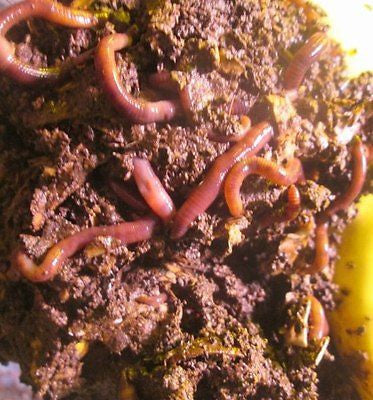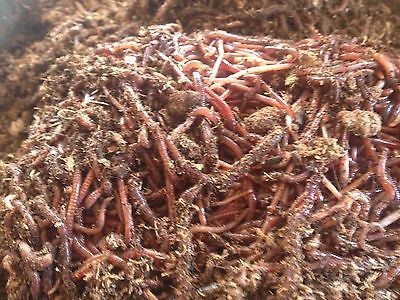Why Red Wigglers Are the Finest Option for Your Composting Requirements
Red wigglers have become a premium option for composting because of their remarkable capacity to effectively break down raw material while producing high-grade worm spreadings. Their adaptability to numerous environments permits versatile applications, making them appropriate for both city and rural composting setups. Additionally, the nutrient profile of their castings considerably benefits dirt health, advertising sustainable horticulture techniques. The trip to effective vermicomposting includes even more than simply getting these worms, and comprehending the ideal conditions and false impressions surrounding them is essential for maximizing their potential.
Advantages of Red Wigglers

Red wigglers flourish in a variety of conditions, making them adaptable to different composting setups, from small bins to bigger systems. They master vermicomposting, where their task produces a top notch output called worm spreadings, abundant in helpful bacteria and nutrients vital for plant development. This natural plant food advertises soil wellness, improves wetness retention, and boosts plant strength against insects and illness.
In addition, using red wigglers can significantly decrease methane emissions linked with garbage dump waste, adding to ecological sustainability. Their ease of care and very little upkeep demands make them suitable for both newbie and skilled composters. Inevitably, integrating red wigglers into your composting approach not only promotes effective waste management yet additionally boosts the quality of your compost.
Suitable Composting Problems
Creating optimum composting problems is vital for making the most of the effectiveness of red wigglers in breaking down natural issue. These worms prosper in a regulated environment that mimics their all-natural environment, which mainly includes wet, dark, and well-aerated areas. To accomplish this, keeping a temperature level variety of 55 ° F to 77 ° F is crucial, as extreme temperatures can hinder their task or also cause death.
(red wiggler worms near me)Wetness degrees have to additionally be meticulously checked; red wigglers require a wet setting, ideally around 70% moisture material. Way too much wetness can cause anaerobic conditions, while not enough dampness can trigger dehydration. Additionally, a well balanced carbon-to-nitrogen proportion, ideally around 25:1 to 30:1, supports optimum digestion and nutrient biking.
Furthermore, the composting tool should be maintained loosened and oxygenated, permitting appropriate airflow. This not only profits the worms yet additionally aids check it out in the breakdown of organic materials. By making certain these optimal conditions, composters can develop a flourishing ecosystem that enhances the effectiveness of red wigglers, ultimately bring about abundant, nutrient-dense garden compost.
Exactly How to Begin Vermicomposting
Beginning vermicomposting is an uncomplicated procedure that can produce significant benefits for both your yard and the environment. To begin, choose an appropriate container, such as a plastic bin or a wooden box, ensuring it has ventilation holes for air flow. A dimension of around 15 to 20 gallons is suitable for small operations.
Following, prepare the bed linens material, which need to be a mixture of shredded paper, cardboard, and coconut coir. This bed linens offers a comfy habitat for the worms while keeping wetness. Go for a bedding depth of about 4 to 6 inches.
When the bed linen prepares, introduce red wigglers into the container. A populace of around 1,000 worms is sufficient for refining kitchen scraps efficiently. After including the worms, include a well balanced mix of eco-friendly materials, such as vegetables and fruit scraps, together with brownish materials, like dried out fallen leaves.

Nutrient-Rich Spreadings
(red wiggler worms for sale near me)The red wigglers in your vermicomposting system play a crucial duty in generating nutrient-rich castings, a very desired organic plant food. These castings, usually referred to as worm humus, are the result of the worms digesting raw material and excreting it in a form that is incredibly valuable for plants.
Rich in vital nutrients such as nitrogen, phosphorus, and potassium, worm spreadings supply a well balanced source of fertility that boosts soil framework and promotes healthy plant development. In addition, they have beneficial microbes that better improve dirt health, helping in nutrient absorption and disease resistance.
The slow-release nature of worm castings makes sure that nutrients are available to plants over an extended period, minimizing the threat of nutrient leaching and hence adding to lasting gardening methods. Unlike synthetic fertilizers, which can result in dirt deterioration over time, worm spreadings boost the dirt's physical, chemical, and biological properties.
As a result, integrating red wigglers right into your composting efforts not just reduces waste however also creates a costs organic change that substantially benefits yards, landscapes, and potted plants alike. - red wigglers
Usual Misconceptions Concerning Worms
While many individuals identify the advantages of using worms in composting, a number of misconceptions persist regarding their biology and actions. One common myth is that all worms are just as reliable for composting, when actually, only specific varieties, like red wigglers, prosper in organic waste atmospheres. These worms are especially adapted to composting, making them suitable for this purpose.
An additional misconception is that worms are vulnerable and call for extremely details problems to make it through. In truth, red wigglers are quite durable, able to endure a range of temperature levels and moisture levels, provided they are kept within an appropriate variety.
Furthermore, some think that worms eat all types of food waste indiscriminately. Nonetheless, red wigglers prefer specific natural materials, such as vegetables and fruit scraps, and can battle with meat, dairy, and oily foods, which can develop smells and attract bugs.
Final Thought
In conclusion, red wigglers represent an optimal choice for composting due to their rapid decomposition capacities and versatility to different environments. Comprehending the ideal problems for vermicomposting and attending to usual mistaken beliefs regarding these worms even more solidifies their role in efficient waste management.